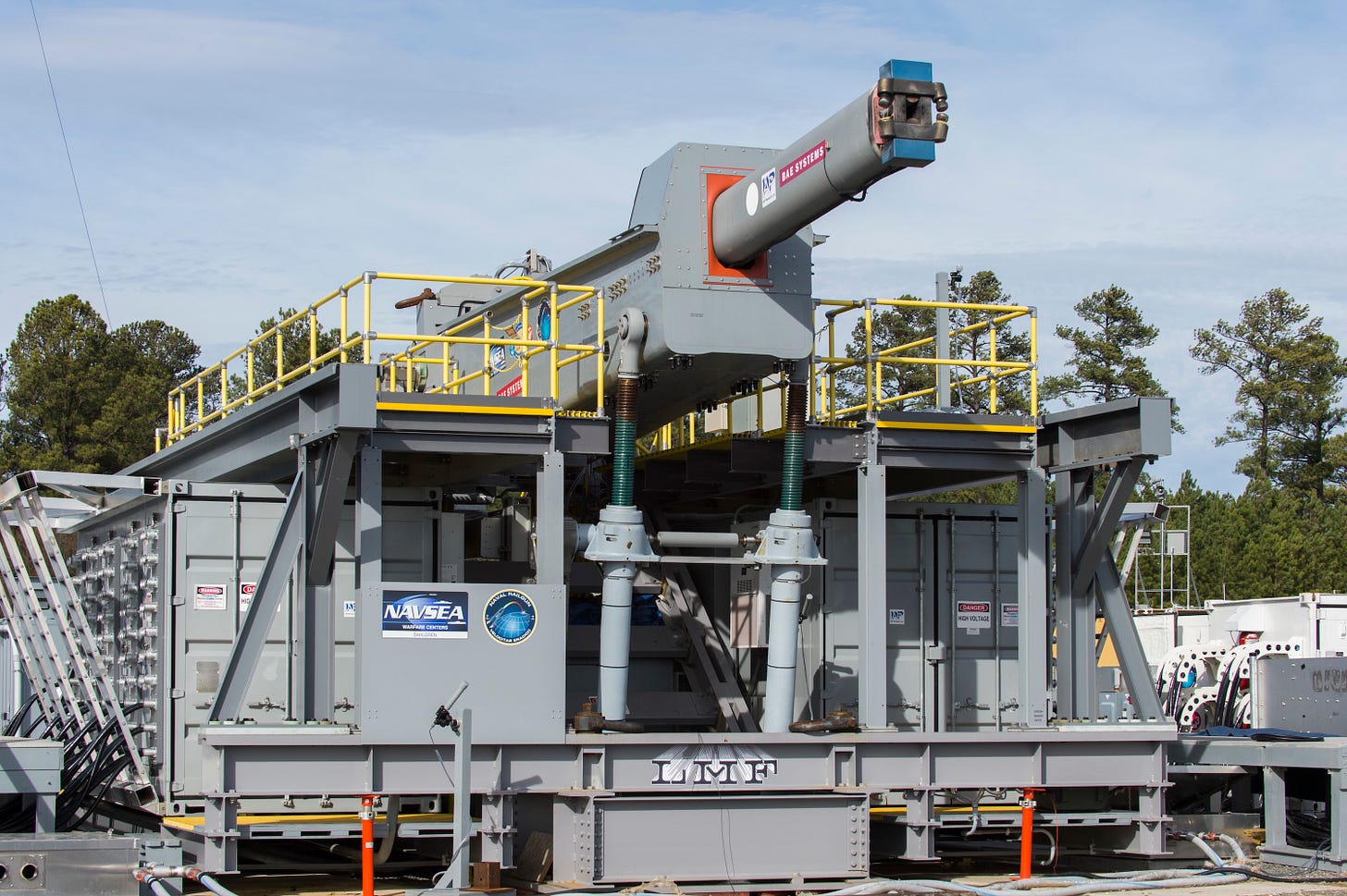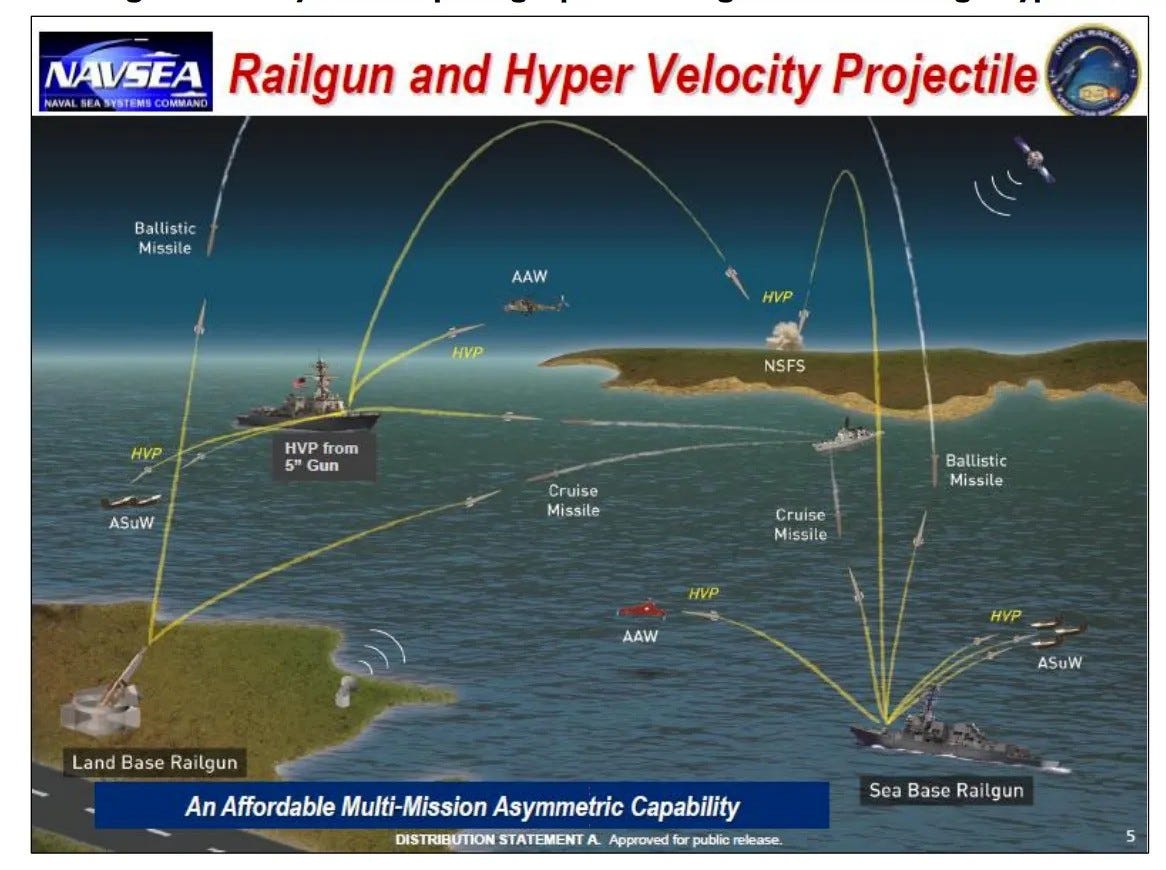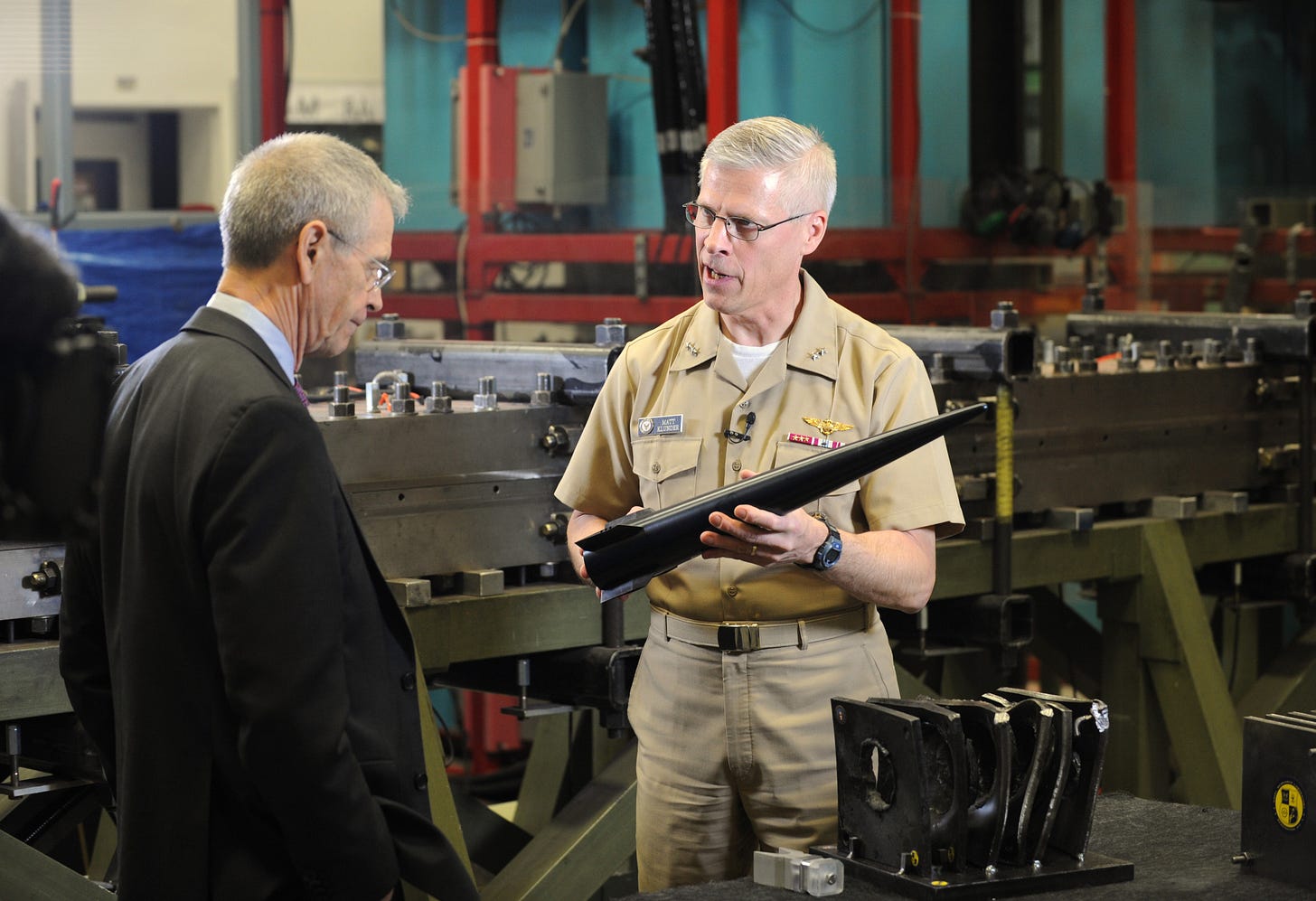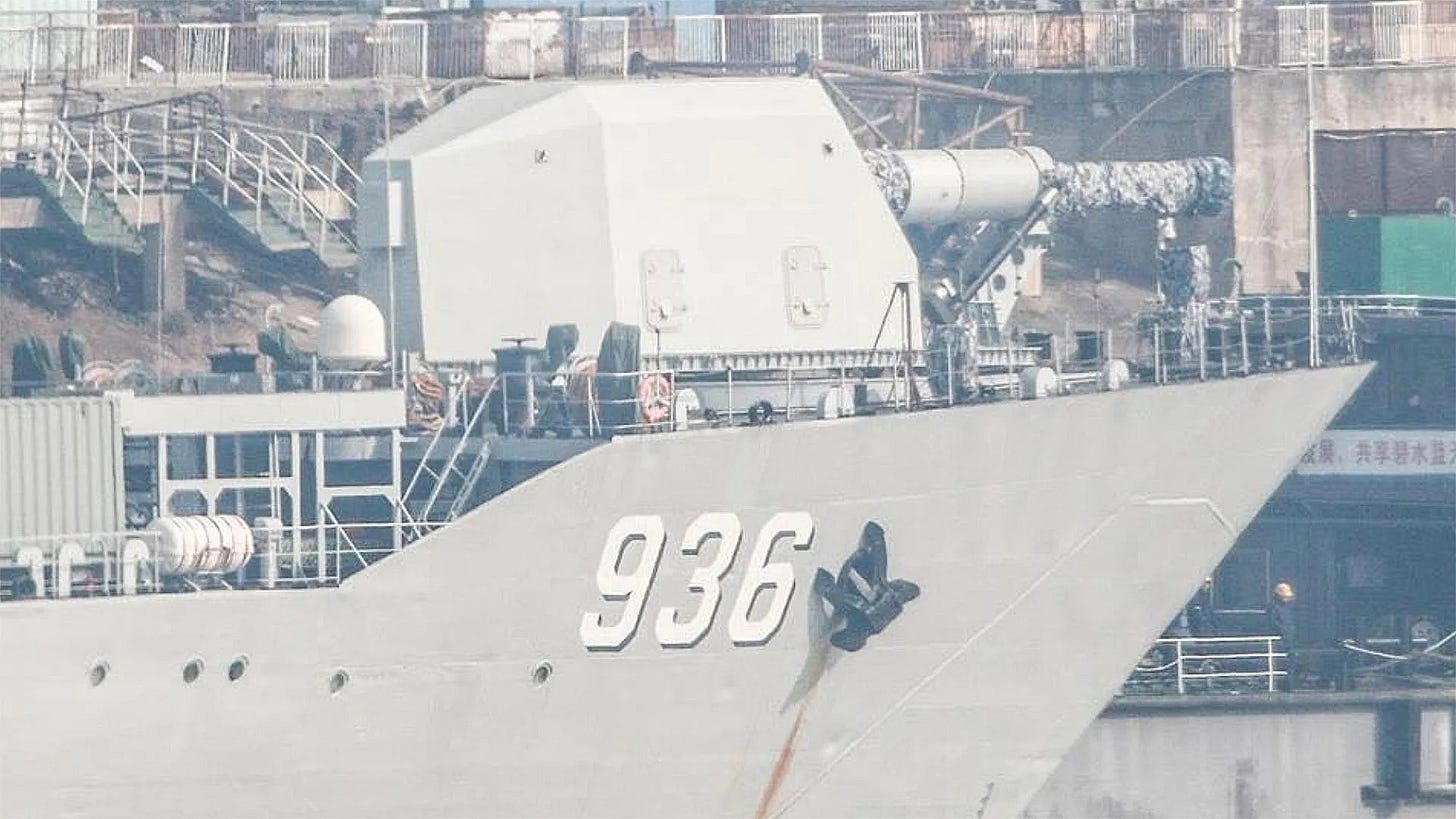Why Japan’s Electromagnetic Railgun Succeeded Where the US Navy’s Failed
Developing next-generation weapons is as much about political optics as it is technical prowess.

Editor’s note: Yes, the name of this newsletter is Laser Wars, but electromagnetic railguns are technically directed energy weapons and I’ve been tracking the progress of these systems for years, so let’s just go with it, OK?
It can fire off solid metal rounds at nearly six times the speed of sound. It can nail targets and defeat enemy armor at ranges of up to 100 nautical miles. And despite the fact that the US Navy abandoned efforts to build one after nearly two decades of research and development, the futuristic weapon of US military planners’ dreams may finally see combat on the high seas – just from the bow of a Japanese warship rather than an American one.
The Japan Maritime Self-Defense Force (JMSDF) on April 18 released fresh photos of a boxy turret enclosing an electromagnetic railgun – a directed energy weapon that uses powerful electromagnetic fields rather than chemical propellants to accelerate projectiles to deadly velocities – installed aboard the experimental testbed ship JS Asuka.
In development by the Japanese Ministry of Defense’s Acquisition Technology & Logistics Agency (ATLA) R&D unit since 2015 and designed to both intercept incoming hypersonic missiles and function as naval artillery, the JMSDF’s 40 mm electromagnetic railgun can purportedly launch a 320 gram projectile at more than 2,000 meters per second, or nearing Mach 6.
The new photos of the electromagnetic railgun, taken on April 9 during a visit to the Asuka by the JMSDF’s Self Defense Fleet boss Vice Adm. Omachi Katsushi, are the first to emerge since the Japanese military’s successful test firing of the system from an unspecified maritime platform in October 2023, the first known at-sea test of a railgun ever.
“In preparation for future combat, the Self Defense Fleet promotes research, development, and earlier introduction of equipment necessary for the JMSDF in close collaboration with the ATLA and other organizations, as well as continues to build up its defense posture to protect Japanese citizens and the territorial waters,” the JMDSF said in a statement accompanying the new photos.
Watch the Japanese military test-fire its electromagnetic railgun at sea:
The appearance of the turret aboard Asuka represents not just a triumph for the Japanese military, but a victory for electromagnetic railgun technology in general. Indeed, Japan appears to have not only benefited from years of US military research, but also managed to skirt the “valley of death” between R&D and procurement that doomed the US Navy’s aborted electromagnetic railgun effort. America’s railgun dreams may be dead, but their spirit lives on in Japan’s new naval supergun.

The idea behind the electromagnetic railgun isn’t new. The concept of using electricity to launch projectiles at high speeds dates back at least to World War I, and the US Defense Department in particular has pursued such technology since the 1980s. The development of the Navy’s shipboard electromagnetic railgun began in earnest in 2005 following years of preliminary studies, with the service pouring $954.6 million into the project over the next two decades to develop a prototype system in conjunction with defense giants General Atomics and BAE Systems that could defend against incoming missiles, according to a 2022 Congressional Research Service report on the program.

The Navy’s railgun venture was, in some ways, a success. In November 2016, the Office of Naval Research (ONR) released footage of a land-based demonstrator firing off its first round at the Naval Surface Warfare Center, Dahlgren Division’s Terminal Range in Virginia; by the following July, the rig was firing off multi-shot salvos of 4.8 shells a minute on Dahlgren’s 25-mile Potomac River test range, inching closer to the Navy’s stated firing rate requirement of 10 shells a minute. There were still technical challenges to consider, like finding a warship testbed with the appropriate “pulsed-power architecture” capable of juicing those lethal electromagnetic fields, but the system worked – on land, at least.
Watch the US Navy fire multi-shot salvos from its electromagnetic railgun:
This is where things started to get off track. In late 2017, I reported for Task & Purpose that a combination of budget pressures and changing priorities within the Pentagon indicated that the Navy could end up without the requisite funding to actually install the electromagnetic railgun on a surface vessel, a critical testing milestone that would not only validate the technology but drum up crucial support from both military and legislative stakeholders. As one defense contractor with direct knowledge of the program told me at the time, the railgun would likely end up “dead in the water” within the next few years.
They were right: In July 2021, the Navy confirmed that it had “decided to pause” R&D on the much-hyped supergun due to “fiscal constraints, combat system integration challenges and the prospective technology maturation of other weapon concepts,” as the service told Military.com in a statement.
So what actually killed the Navy’s electromagnetic railgun? For one, the Pentagon’s Strategic Capabilities Office (SCO) realized in 2015 that the railgun’s hypervelocity projectile (HVP) – the specialized super-dense shell the Navy developed specifically for the system – was just as effective when fired from the Mk 45 5-inch guns that adorn the decks of warships like the Arleigh Burke-class destroyer and Ticonderoga-class cruiser. Indeed, a 2016 Center for Strategic and Budgetary Assessments study indicated that those guns could fire off HVPs at Mach 3 at ranges between 10 to 30 miles, offering a relatively cheap solution that the Navy could rapidly field across the fleet without waiting for ONR to perfect the insanely complex railgun.
“We thought railguns were something we were really going to go after, but it turns out that powder guns firing the same hypervelocity projectiles gets you almost as much as you would get out of the electromagnetic railgun, but it’s something we can do much faster,” as then-Deputy Defense Secretary Robert Work told lawmakers in May 2016. (A spokesman confirmed to me at in 2017 that SCO had “shifted the project’s focus to conventional powder guns, facilitating a faster transition of HVP technology to the warfighter.” As of 2024, the HVP — subsequently known as the Gun Launched Guided Projectile — was being adapted for use in the US Army’s new Multi-Domain Artillery Cannon system.)

In response to SCO’s changing priorities, funding for the electromagnetic railgun began to steadily decline in the Navy’s annual budget requests starting in 2015. As a result, so did resources for what’s known as a “common mount,” a universal mechanism for integrating the railgun onto both land and sea-based platforms that the Navy began to research in 2015. This wasn’t necessarily a surprise: a 2016 House Armed Services Committee report had warned that SCO’s shifting focus on the HVP had “left the Navy with a funding gap in developing the requirements and design for a common mount, which is a necessary prerequisite to getting this capability into operational use.”
That warning was prescient. Without funding for a common mount, there was no path forward to actually install the railgun on a surface warship for an at-sea demonstration, which in turn meant no real-world proof for both military and legislative stakeholders that the system was ready for prime time and, therefore, worthy of additional resources. As I wrote back in 2017, successfully developing next-generation technology over several years is as much a matter of political optics as it is technical prowess: without actually demonstrating the efficacy of new systems in a visceral, impactful way, most moonshot projects end up doomed to R&D purgatory, unable to garner the resources to transition to widespread fielding – the dreaded “valley of death.”

This is (likely) why Japan succeeded where the United States failed. Not only did Japan rely heavily on existing Pentagon research (as well as that of the French and Germany militaries) in developing its own railgun system, but ALTA appears to have invested a sustained amount of resources into developing a shipboard demonstrator to serve as proof-of-concept for Japanese military stakeholders without the distraction of competing priorities within the Japan Ministry of Defense. As Naval News notes, ALTA conducted its major research on electromagnetic acceleration between fiscal years 2016 and 2022, with additional research into refining the actual gun system set to continue through fiscal year 2026. The appearance of the railgun on the Asuka is a validation of railgun R&D that the US Navy never achieved, indicating that the Japanese military remains committed to putting the system into operational use.
It’s worth noting that Japan isn’t the only country pushing ahead with railgun technology. In February 2018, images emerged online of a China’s People’s Liberation Army Navy Type 072III-class landing ship equipped with what appeared to be a railgun turret installed on its bow. Meanwhile, Turkey has been pursuing the development of an indigenous naval railgun system since July of that year.

Whether Japan’s electromagnetic railgun proves an effective weapon under real-world combat conditions remains to be seen. But one thing is clear: the railgun wars are coming – it’s only a matter of when.



It remains to be seen whether this is an effective class of weapon at all. Major problems remain in getting the power sources for sustained fire or rapid fire, and the durability of the weapon to survive repeat firings. Maybe the special case of defending against hypersonic attacks is a niche where a low fire rate and low durability would be acceptable. For general use the idea ro fire similar projectiles from standard 4.5 inch guns seems far more practical
.
This is another example of our military procurement system at its worst. When I look back at the history of it, from rifled bores to repeating rifles to aircraft to aircraft carriers, all “things we don’t need” to the Zumwalt class, LCS, Davy Crockett, and atomic cannon, all “stuff we gotta have”, I wonder how we ever survived. Maybe we can buy a weapon from Japan or China?